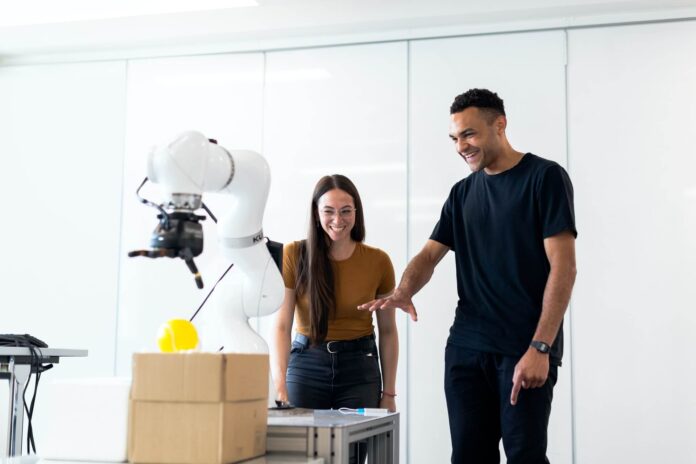Robotics is the branch of technology that deals with robotics that works in coordination with human beings.
The word robotics was coined by Isaac Asimov to describe the science of robotics and its impact on society. He combined the Greek word for ‘work’ or ‘construct’ alongside “Ion” which is the root of the word “mechanics”.
While most robots don’t look humanoid some types have features resembling human parts however they may be simplified or exaggerated for convenience, robotics is about making things quicker, easier, and more efficient so it makes sense that robotics would adopt features humans already have used.
Truly functional robotics cannot do everything a human can do but they come very close, the only areas in which robotics lag behind are tasks requiring higher cognition such as speech recognition and general problem solving however this is due to their dependence on computer assistance.
Most robots are made for one specific task but there are some multi-purpose units available these usually have numerous arms to make many simultaneous movements allowing them to perform different tasks.
Some of these arms are used for manipulating objects while others may be equipped with specialized tools or implements designed to make certain jobs much simpler or even possible at all. Other essentials robotics must have are sensors that allow it to see and feel its surroundings while also making many small adjustments to keep it balanced.
The History of Robotics
The robotics industry has existed in some form since the dawn of robotics — when Karel Capek’s 1920 play R.U.R (which coined the term “robot”) was published, and when Fritz Lang’s 1927 movie Metropolis brought robotics into popular culture.
Since the creation of the first industrial robot over 50 years ago, robotics technology advances have been accelerating rapidly. The robotics industry itself is largely split between two primary fields: robotics used in manufacturing, and service robotics drones robots ). The manufacturing sector largely consists of large-scale industrial robots which are often called ” automated guided vehicles “.
Service robotics can be subdivided into three key categories: domestic robotics, personal service robotics Personal Service Robots, and healthcare robotics. Many experts believe that robotics will become an integral part of daily life, and robotics is projected to be a $135 billion industry by 2025.
Early robotics were based on complex mechanical devices such as the Automatons designed by Hero of Alexandria and constructed in the 3rd century BC, or the artificial dove crafted by Archytas in 350 BC.

By comparison, some modern-day robots are based on modern-day electronics — using electrical signals to trigger movement instead of complicated clockwork mechanisms with springs and gears.
In his 1920 play R.U.R., author Karel Čapek introduced the word “robot” (meaning “slave” in Czech).
NASA’s Mars Exploration Rovers (MER) were designed to last a few months but lasted for over five years.
Robots began appearing as fictional characters in works of science fiction almost from their inception, such as Maria in Fritz Lang’s Metropolis.
From the 1940s onwards, beginning with groundbreaking work on robotics by both Alan Turing and John von Neumann, robotics became increasingly visible in both scientific research and popular culture. In particular, roboticists began focusing on the idea that someday robots might be able to walk upon two legs rather than crawl upon four. This vision led to the creation of the first “knee-walker” robots, which were built in 1978.
As robotics became more widely studied, new robotics began to emerge: service robotics – robotics designed to assist humans rather than simply replace them. These systems emerged from the fields of computer science and microelectronics – an area is known as embedded systems – and it is here – rather than with larger robotic arm/hand systems – that modern robotics truly begins.
In 1956, an Italian company produced a toy called Elgeeth, which was later licensed by the American toymaker Wham-O under the name ” Frisbee .” The idea behind Wham-O’s toy inspired Japanese engineer Tomy Kamada to create a remotely controlled version named ” Happy-Go-Lucky .” In 1957, Japan’s Jareco robotics company produced amphibious and later fully aquatic robotics called ” Otoron “, which also had lights and made sounds.
The modern robotics industry emerged in the early 1980s, although the term did not come into popular usage until much later. The first robotics companies were founded in the early 1980s by Rodney Brooks, Marc Raibert, and others at MIT.
The Future of Robotics
Major changes are envisioned, such as robots moving from external hardware to being internalized into our bodies. Advancements in robotics have had their focus on either everyday functional tasks or human functions, but this may change in the future where robotics can potentially build themselves and morph into other shapes.
The robotics industry envisions a more robotic-based society where robotics can work together with people for maximum efficiency, instead of working separately making them seem like more of an assistant than a worker.

A robotics company called “Vecna” is currently working on creating robotics prosthetics that could allow robotics technology to be absorbed into the human body minimizing the need for robotics machinery (Hawk). This is just one example of robotics morphing into an internal function, where it could theoretically begin being used as replacement parts in the body rather than just being external.
The robotics industry has created 3D printers that use metal alloys and polymers but are now also beginning to use food products such as chocolate or sugar to create sculptures or candy treats(RobotFood).
These types of advancements show how robotics can provide artistic services for people providing more comfort and convenience. As 3D printing continues to become more affordable, robotics companies are looking at other ways robotics can provide these types of functional tasks.
Robotics in Different Fields of our life?
The current trend in the fields of robotics is creating ways for robots to take over everyday functional tasks, but robotics can also be used for other purposes.
For example, companies are beginning to use 3D printers that can create metal alloys and polymers with food products such as chocolate or sugar (RobotFood). This has allowed for creative services to not just be made available to people but also provide convenience by having them come directly to them.
The goal of future robot development is will be bringing robots together with humans instead of keeping them separate like they currently do now.
Robots today are mainly designed for specific functions which do not promote interaction between human workers and robots leading one working separately from another. For example, an assembly line would be more efficient with robots working alongside human beings than just using robotics machinery to do the tasks separately. This would lead to a better environment and increased production in factories.
The use of magnetic fields is currently being used in robotics for locomotion, but this may change in the future where they can potentially allow a robot to move autonomously (Wandell).
This advance may allow for a robot’s external hardware to be internalized into our bodies making it more functional and minimalistic while also allowing robots to fuse together creating new robotic species.
Robotics is still a rapidly growing field so there will be lots of exciting and innovative things happening in robotics research and development in the future.
This post was originally published on 18, December 2021, but according to new information stuff, this post is updated frequently.
Editor Recommendations:
>What is Artificial Intelligence? Explained
>What is Machine Learning? Explained
>What is Quantum Computing? Explained

